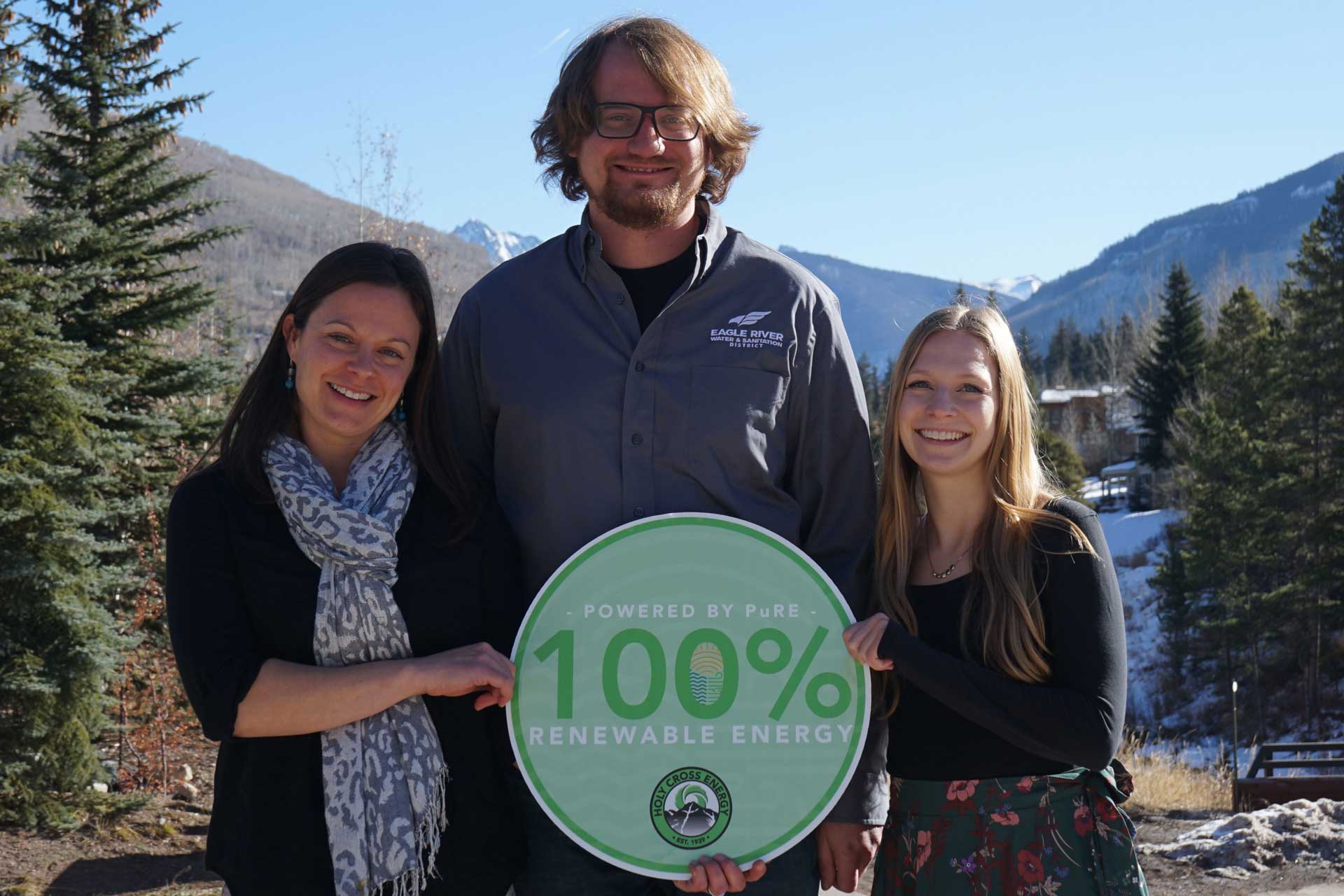We’re featuring our partners who help contribute to Holy Cross Energy’s goals and are leaders in the areas of sustainability and climate action. We had an opportunity to meet with the Eagle River Water & Sanitation District (ERWSD) to talk about the organization’s partnership with HCE and their long-term sustainability goals.
Tell us about your organization
Eagle River Water & Sanitation District is a local government responsible for the public water systems and wastewater treatment system that serves customers from East Vail to Cordillera. We serve a population of roughly 27,000 people, though that number can more than double during holidays and other peak tourism times. Regardless of the population size we’re serving, our mission is to conduct our operations in a manner that respects the natural environment.

(Left to Right) Catherine Hayes, Byron Nelson, Kira Koppel
What is the driving force behind ERWSD’s sustainability and climate action initiatives?
Sustainability efforts are key to providing clean water to our community. Our ability to do this depends on a healthy natural environment and ensuring a sufficient water supply for our customers, both now and in the future. We have limited water storage and rely on local waterways for many uses that are central to the quality of life our community expects and appreciates; therefore, we depend on precipitation, especially snow.
In a perfect world, we’d have lots of snow every winter that melted off slowly to provide a consistent amount of water in local streams for treatment and distribution to our customers. In the real world, however, precipitation and runoff are variable and unpredictable. Climate change further complicates matters, as a warming climate is reducing the amount of water available in western streams. With a drier future ahead, our customers will have to be more efficient with a decreased amount of water as we serve a growing population. Our efforts to reduce greenhouse gas (GHG) emissions through the course of everyday operations will have a positive impact on our local environment and ensure our ability to serve our customers.
What is ERWSD currently doing to make sustainability and climate action a priority for the organization?
The district maintains an active Sustainability Committee that continually works to infuse sustainability into our operations. We have a comprehensive waste diversion program, through which we encourage district-wide recycling and composting, including hard-to-recycle items like soft plastics and lab gloves. Since February 2019, our composting efforts have saved more than 6 metric tons of greenhouse gases from entering the atmosphere – and that is just for our Vail location. We also actively work on improving our energy efficiency, including HVAC upgrades in our office spaces, home energy assessments on each of our employee housing units, and incorporating renewables where possible. We have solar panels at our new Stillwater employee housing neighborhood, which power the common area lighting as well as the two dual-port electric vehicle (EV) charging stations there. Since transportation is required for us to maintain operations, we prioritize efficient vehicles and EVs when possible, and we have several EV charging stations on site. Our 2019 EV mileage alone reduced our transportation-related greenhouse gas emissions by 4.9 metric tons.
Finally, we consider the sustainability of our purchasing strategy, aiming for low-waste products that can be donated, recycled, or composted at the end of their useful lives. We also factor in the emissions produced from receiving shipments. Our staff participates in a variety of local organizations and partnerships that focus on sustainability and climate action. The district is a proud member of the local Climate Action Collaborative, the state Environmental Leadership Program, and is Actively Green certified at our Vail office. We have benefited from partnerships, learning about what other local organizations are doing to reduce their impact, exchanging ideas, and continuing to get new ideas and inspiration from the success of other local entities.
When did ERWSD join HCE’s PuRE program and why? What is the benefit to ERWSD and to your customers?
The district is an enthusiastic participant of HCE’s PuRE program, offsetting 100% of our electric use with wind power. We joined PuRE in January 2019 for a variety of reasons, the most prominent being to help HCE reach its renewable energy goals and because it’s just the right thing to do. We hope to inspire other HCE customers, large and small, to participate as well.
ERWSD was the first organization to participate in our Peak Time Rebate (PTR) pilot program. What was the motivation to join PTR and has the organization seen any savings so far?
The district is one of HCE’s largest electric users; water and wastewater treatment are very energy-intensive processes. Mike Steiner, HCE’s key accounts specialist, approached staff about the PTR program in late May. Mike was already familiar with operations at our Edwards wastewater treatment facility (EWWTF) from a tour of the facility and its processes in early 2019. Mike recognized the potential for energy reductions at the facility during peak times, and staff at the facility was eager to take on the challenge to become even better environmental and financial stewards. We’d always wanted to reduce our use, but weren’t sure where to begin. The PTR program put us at the start line with EWWTF as our guinea pig facility. Using knowledge of the facility and the biological processes involved, our operators were able to temporarily shut down major pieces of equipment when HCE called for a reduction of energy use without upsetting the treatment processes and still meeting all regulations.
In addition to energy reduction during PTR events, EWWTF staff found ways to reduce energy use and optimize equipment during all hours, further reducing our GHG emissions at the facility. Lessons learned and new processes are being shared with operators at our other facilities, with the expectation of reduced electric use across the organization. This has enabled us to consume 4.4% less power this year compared to 2018. This is the equivalent of reducing almost twelve years’ worth of average household electric use in our area.
District staff is also prioritizing replacement of aging major electrical equipment with new, energy-efficient technology. Water and wastewater operations depend on a lot of different equipment, and these replacements have a huge potential for GHG emissions reductions. Staff is also streamlining energy tracking, looking at a software solution to quickly identify facilities and equipment using large amounts of energy at certain times or in the course of each billing cycle. This will highlight areas for improvement and/or equipment malfunctions that might otherwise go unnoticed.
What are ERWSD’s future goals around sustainability?
The district will continue looking for opportunities to incorporate sustainability projects into everyday operations. We are actively seeking grant funding for efficiency upgrades and other projects, which benefit employees and customers. The district vehicle fleet currently includes three EVs, and staff received grants for the installation of multiple EV chargers over the years. We are looking for opportunities to bring renewable resources onto the Holy Cross grid by investigating solar and hydroelectric resources. Our waste diversion rate has more than doubled since 2017 with the implementation of compost at our facilities, as well as promotion of recycling and other means of diverting waste from landfills. We plan to continue our active involvement in the organizations mentioned above, doing our part and supporting our fellow partners as they do theirs. We would like to get all of our facilities Actively Green certified, in addition to some other programs to reduce our GHG emissions and make our operations more sustainable.
Anything else you’d like our members to know about ERWSD?
We are so grateful to have HCE as our local electric utility. Their staff has been helpful and creative in providing grants, knowledge, and hands-on assistance at our facilities. We have definitely benefited from their proactive involvement in our electric use, and we are confident we can continue to make reductions during peak use times and find ways to help HCE meet their renewable energy goals.

Technically speaking with Byron
Byron Nelson, Wastewater Operator, works directly with the district’s sophisticated equipment every day. He gave us some insight into how sustainability impacts operations. Here’s what he had to say:
I’d say our participation has been very successful in a multitude of ways. We have the obvious sustainability reason, which I believe has been a success even without the rebate incentive. We’ve learned some lessons we would not have otherwise encountered. During the Peak Rebate Events at Edwards wastewater treatment facility (EWWTF), we entirely offload our major blowers for our aerated biological treatment process instead of running our back-up generators. Biology is tricky to predict but can also be resilient within a certain range. With public health being part of our job, we often err on the side of caution, which can result in a bit of over-treatment and therefore additional, unneeded energy use. During the first PTR event, we saw firsthand how conservative we truly have been in our treatment process. Shutting down equipment to reduce energy has been a major success, with the process usually bouncing back to normal within an hour after the event ends. Most importantly, the high quality of our final effluent – the water we return to the Eagle River – remains the same; we are still putting clean water back into the river for the aquatic life, recreators, and downstream water users. By doing things out of our normal routine, we learn more about our process and change our habits and expectations. These type of adjustments and optimization efforts will become routine, everyday occurrences as we work to combat climate change in the future. The sooner we embrace these lessons as an organization and incorporate them into our culture, the more prepared we will be for the future.
District staff is also working on other sustainability efforts on the operations side. Our senior electrical technician is investigating replacement of our major electrical drives, starters and motors, which are well-maintained but aging. Every motor starter nearing the end of its usable life is being evaluated for replacement with standardized and more efficient VFDs (variable frequency drives). We recently replaced a 500-lb., 15-year-old drive. The new drive was small and light, lifted by a single technician. Multiply this efficiency measure by the hundreds of electrical drives we have across the valley and the potential reduction in the footprint becomes very large.
We are also looking at installing power monitors in every motor control center in the district. The district receives more than 130 electric bills each month. The ability to further break them down and pinpoint exactly where the power is being consumed will improve our efforts to reduce demand and operate in an increasingly sustainable manner.
Another major sustainability priority involves experimenting with different process configurations at EWWTF, the district’s largest electric consumer. It’s not always possible to alter what we are doing, but we have been using each bit of information about our power usage to see what equipment we can minimize or go without. This enabled us to consume 4.4% less power so far this year compared to our 2018 usage. This equates to enough savings to power the average house in the Holy Cross service area for 12 years!
Alongside the Peak Time Rebate program, our senior electrical technician has started to investigate replacing our major electrical drives, starters and motors. We have a lot of well-maintained but aging equipment. Every motor starter is being evaluated for replacement with standardized and more efficient VFDs (variable frequency drives). We recently replaced a drive that was installed about 15 years ago. It was massive compared to its replacement, 500 pounds versus a drive that a single technician was able to lift by himself. The smaller heatsinks, fans, and with all the advancements in efficient technology that have happened in the past 15 years, will most certainly add up over the course of this drive’s lifetime. Multiply this efficiency measure by the hundreds of electrical drives we have across the valley and the potential reduction in the footprint becomes very large.
In addition to the drives and motors, ERWSD is looking at installing power monitors in every motor control center in the district. As an organization, we receive over 130 power bills each month. The ability to further break them down and pinpoint exactly where the power is being consumed is very empowering in our efforts to reduce demand and operate in an increasingly sustainable manner.
Another major sustainability priority involves thinking outside of the box and experimenting with different process configurations at Edwards Wastewater (EWWTP), our largest power consumer. It’s not always possible to alter what we are doing, but we have been using each bit of information about our power usage to see what we can minimize or go without. This enabled us to consume 4.4% less power this year compared to 2018. This is the equivalent of 12 months of the average power bill for our area.

No Comments
Sorry, the comment form is closed at this time.